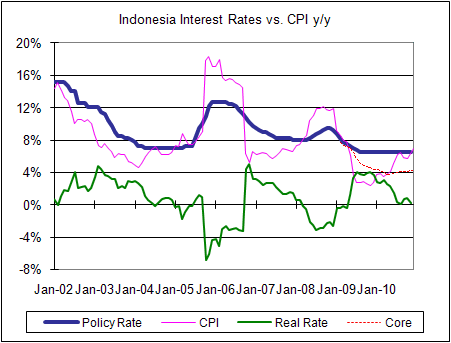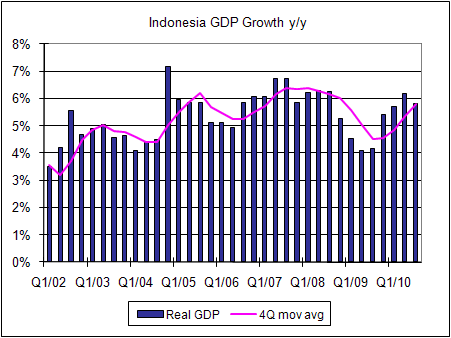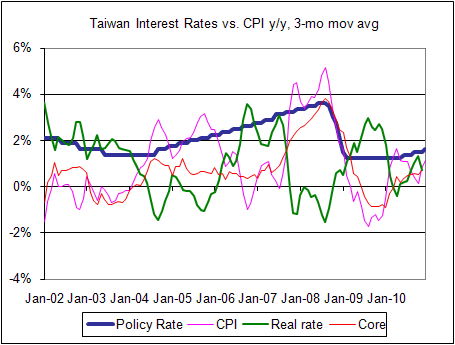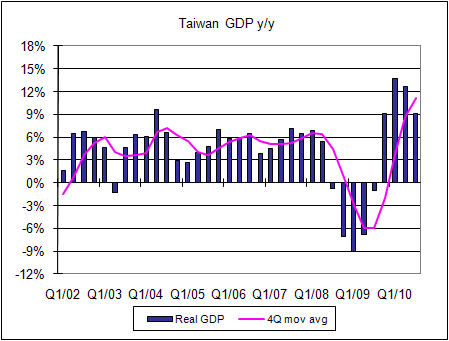Asian Policy-Makers Face Dilemma Of Too Many Targets
by Win Thin
Bank Indonesia kept rates steady at 6.5%, as expected. However, we disagree with its dovish stance. Inflation pressures are rising, and tightening should have begun in 2010. Headline inflation was 7.0% y/y in December, the highest since April 2009 and well above the 5% +/- 1 percentage point target band for both 2010 and 2011. While much of this is driven by food prices (up 15.6% y/y in December), we note that core CPI has been creeping higher to 4.3% y/y in December. The pass-through from headline to core CPI is typically pretty quick in emerging Asia. Also, Indonesia avoided recession and so the output gap is closing fast. IMF estimates that the gap will close by September 2011, and also has a Taylor-rule model that put the optimal policy rate at 7.5% in 2010 and 8.5% in 2011. Indonesia offers high yields, good economic fundamentals, and strong equity market potential, but we think BI needs to establish some credibility by hiking soon. Official acknowledged today that capital inflows are playing a big part in policy decisions. IDR underperformed emerging Asia in H2 after outperforming in H1, due partly to fears that on-going rupiah strength would be met with further capital controls. USD/IDR made a cycle low around 8881 in early November. We think there remains a significant risk of more capital controls should IDR retest that low. However, as investors in Brazil are finding, even a stable currency is palatable as long as high interest payments are being received.
On the flip side, Taiwan is experiencing very limited price pressures and for now this supports the central bank’s very cautious tightening path of 12.5 bp per quarter. Headline CPI rose only 1.3% y/y in December even as core CPI remains below 1% y/y. For CBC, the argument for allowing a stronger currency to limit inflation is clearly not as compelling as it is for others in emerging Asia. Still, TWD outperformed in Asia during Q4 after underperforming for most of 2010. With Taiwan rates now at 1.625% and the central bank continuing to intervene to limit TWD gains, we think that TWD outperformance is likely to wear off a bit in 2011 despite the very good underlying fundamentals from the economic ties to mainland China. However, we do expect TWD to continue rallying along with the rest of EM as investor sentiment remains positive. Here too, there is risk of more capital controls on further TWD gains. USD/TWD recently broke trendline support dating back to 2005. Near-term level ahead is around 28.95 (high from 1997 as well as 62% retracement level of the move since 1995). TWD gains will likely be a very slow grind.
We think one of the biggest problems facing EM central banks now is that they are trying to target too many things with monetary policy. We believe it is ultimately a folly for EM central banks to target inflation AND the exchange rate at the same time. For instance, Indonesia desperately needs higher rates to meet its inflation target and yet it is resisting hikes because it is also targeting the IDR rate as well. At some point, this will have to break down. Indeed, for many EM countries, the stronger currency that typically goes hand in hand with the start of the tightening cycle would help limit inflation pressures, but the default setting for EM policy-makers remains weaker currencies, not stronger. In Asia, the countries that are experiencing higher inflation and thus should be more open to a combination monetary tightening and currency strength are China, India, Indonesia, Korea, Singapore, and Thailand. Malaysia, the Philippines, and Taiwan are seeing limited price pressures and so are seen as remaining much more resistant to rate hikes and currency strength. With Asia enjoying the strongest fundamentals in Asia, we think further currency gains are likely in 2011, especially as more and more central banks there tighten.




Comments are closed.